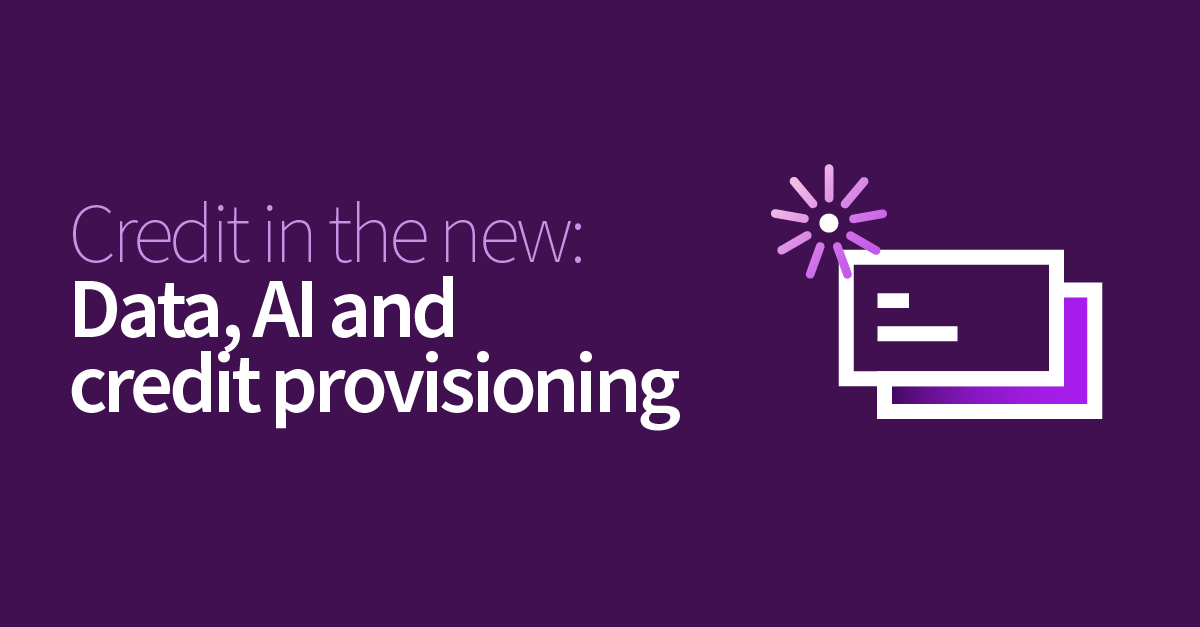Credit in the new: Data, AI and credit provisioning

We had recently explored how changing consumer expectations are forcing banks to become more purpose-driven, especially when it comes to credit provision.
As we set out in our blog, forward-thinking banks who attempt to solve the problems in credit will be rewarded with customer loyalty, acquisition and profitability.
There is no easy answer in transforming how credit is approached with many considerations before products hit the market, to the right audience. But there is movement in this industry with new players approaching the segment much differently than incumbents have.
This poses the question for banks as to how they might move forward and reframe credit provision.
The problem of credit provision
It’s becoming widely accepted that banks need to build new credit experiences and offerings for customers, especially those who come from neglected segments.
To begin this process, banks might think about the challenge in 3 ways:
- Learn to better understand neglected segments of their customer base, seeking to learn what they need and how they can create new products and services that can help.
- Change the mindset of their organisation to encourage new behaviours amongst staff (such as creativity) that leverages tools and processes that extend the reach of credit.
- Leverage technology (especially technologies that use data, such as Open Banking) so that they can reinvent the way credit is offered to these less advantaged segments.
Below we’ll dig into a little more detail about potential solutions.
An age of new products and services
By learning about underserved borrower segments, banks can create new products and services. By understanding these customers better and what they believe and need when it comes to banking, banks can create a new-age of credit profile for this segment.
The range of possible solutions is almost-endless. From special-purpose loans that customers value, for needs such as emergencies or holiday planning, to supply-chain loans for small businesses, the range of options is limited only by the creativity of incumbents and innovators.
For example, Amazon Lending, which offers “working capital loans designed with your business needs in mind”, and “buy now, pay later” products (such as Klarna), should be included when creating credit profiles. Banks can use this data to create a more granular profile of customers.
Change the mindset
When working with underserved customer segments, credit decisions should be more nuanced than a simple yes or no. When it comes to credit, there is often more grey than black and white.
Banks must create a culture that facilitates new customer experiences. From credit decision-makers to relationship managers, the mindset must be, “we’re going to help this customer.” With that thought front and centre, a bank can drive conversion and retention rates. That is not to suggest that banks should abandon caution but a combination of human mindset shift backed up by technology can make a real difference.
For instance, bank staff can be encouraged to embrace this mindset in a number of ways. For example, loan officers could explore ways of making more positive credit decisions, backed up by differentiated data sets to provide more realistic credit solutions for a wider range of customers. Building a culture of experimentation and learning helps to identify behaviours that can be scaled organisation-wide. This mindset shift should be reflected in how staff are hired, trained, incentivized and rewarded.
Increase reach and access
To offer access to more customers, lenders must leverage the customer data that they’ve been gathering for years, as well as go beyond the boundaries of ‘owned data.’ This will reveal patterns that change the structure and accuracy of risk models. Extracting meaningful information from this data with a different perspective can potentially expand the reach of credit and grant access to segments that currently are not served.
Amongst a variety of benefits, this approach can help banks to achieve new analytical techniques, create enriched data and credit scores through data augmentation, and offer banks updated risk models. But, primarily, it helps to better serve a larger number of customers.
Reinvent processes at scale
By leveraging technology, banks can help their staff to enable the provision of credit to underserved segments at scale and at a low cost.
We have identified some enablers that could help to achieve these technology-enabled aims:
- Providing financial education to new customers can bolster relationships and improve creditworthiness. By leveraging digital channels to deliver education at scale, banks can influence behaviour, convert new borrowers and create new data streams.
- Access to alternative data will become essential to the value chain of next-generation credit products. This is just the beginning as access to alternative data becomes essential to the value chain of next-generation credit products.
- Social data from social networks and internet service providers have the potential to be analyzed and used to quantify the qualitative elements of risk analysis.
Lenders of the future
Banks of the future have a unique opportunity. Thanks to technology and, in no small part, data, they can build and deliver seamless credit experiences for a wider range of customers than ever before. Of course, caution is required, as it always is when credit is involved, but the true barrier to growth and progress here is a bank’s willingness to embrace change and innovation.
The very fact of the matter is that the world is shifting to become fundamentally different to the world in which the current banking parameters were created. Changing the very nature of what products are offered, what customer segments exist and leveraging the new technologies that can deliver on these changed mindsets and approaches can steer banks towards a new horizon.
By being aware of the risks, lenders can attract new customers, grow loyalty amongst their existing customers, and reach new levels of profitability. The future of lending looks bright – and the gains will be great for those banks brave enough to take advantage of them.